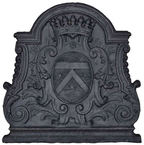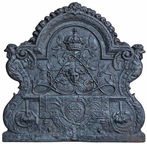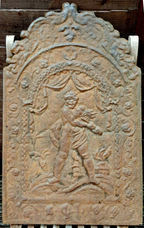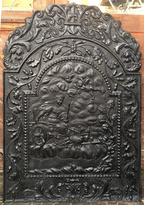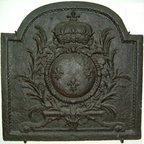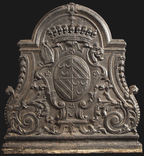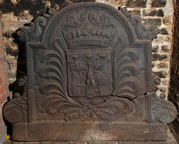-
965
Description: Upon a moulded base plinth, wide scrolled side double fillets with foliage about the scrolls and suspended bell flowers in chain above; central foliate cartouche behind an oval shield surmounted by a viscomte's coronet; on top, an arch rising from horizontal moulding on each side.
Notes: Blazon: Azure, a chevron Argent between three estoiles Or, all surmounted by a bar of the second; characteristic of designs illustrated by architects such as Daniel Marot; the texturing on the shield indicates the azure tincture. See Carpentier p. 234, fig. 644.
Arms: Besset de la Chapelle
- Decoration tags:
- rectangular with round arch (shape)
- complex individual (edging)
- whole carved pattern
- armorial
Manufactured: in the late-17th to early-18th century in France.
Current location: not known.
Citation: Carpentier, H., 1912, Plaques de Cheminées (Paris, published by the author).
- Attached to series:
- Foreign armorial firebacks
-
990
Description: Complex quasi-arched rectangular shape with fillet edging; bell flowers descending from the top of the arch; double fillet scrolls at the side with cockerel terminals; under the arch, a royal crown surmounting a counter-posed double 'L' monogram enclosing a human mask with a sunburst; below, a table draped with a cloth bearing a circular royal shield of France within palm leaves.
Notes: A very elaborate and symbolic design alluding to the Sun King, Louis XIV.
- Decoration tags:
- rectangular with round arch (shape)
- fillet (edging)
- whole carved pattern
- architectural
- monogram
- humans
- plants
Manufactured: in the late-17th to early-18th century in France.
Current location: not known.
- Attached to series:
- Foreign armorial firebacks
-
1220
Description: Arched rectangular shaped central panel with hollow bead edging; to the right, a seated male figure beside a wellhead, pointing towards a standing female resting a ewer on the wellhead over which a rope hangs, and behind the male figure is a tree, and above, swagged drapery; arched rectangular shaped border with fillet edging; swirled flowers and tendrils symmetrically arranged, with SHR monogram at centre bottom; two mirrored stylised sea serpents on top; to each side a vertical extension with bead edging, of the same decoration as the side borders.
Notes: The frame of the central panel and the enclosing border are identical to those noted on another fireback displaying a figure of Pluto (see fireback no. 164), while the pictorial scene, of Jesus and the Woman of Samaria (St John 4: 5-28) is more typical of continental firebacks and stoveplates. This may be an example of an image from one casting being superimposed within the frame of an earlier fireback. The central image is sharper than the surrounding border.
Inscription: SHR
- Decoration tags:
- 'Dutch' (shape)
- bead (edging)
- whole carved pattern
- extension panels
- pictorial
- biblical
- monogram
- text
Manufactured: in the late-17th to early-18th century in England.
Current location: not known.
- Attached to series:
- British 'Dutch' style firebacks
-
164
Description: Arched rectangular shaped central panel with hollow bead edging; draped male figure standing on undulating ground with two small trees, holding a bar, flaming furnaces behind, drapery suspended from above; Arched rectangular shaped border with fillet edging; swirled flowers and tendrils symmetrically arranged, with monogram at centre bottom; symmetrical arrangement of foliage on top.
Notes: The figure is of Pluto, one of a set of 'Eight Deities' engraved by Hendrick Goltzius (1592), after Polidoro da Caravaggio; a recasting, there is a larger (420mm x 640mm) but more corroded version in Hastings Museum. The faint initials SHR are probably those of the pattern-maker. The image is of a copy; original castings are fractionally larger.
Copies of this fireback are known.
Inscription: SHR
- Decoration tags:
- 'Dutch' (shape)
- fillet (edging)
- whole carved pattern
- mythological
- monogram
- humans
Manufactured: in the late-17th to early-18th century in England.
Current location: not known.
- Attached to series:
- SHR series
- British 'Dutch' style firebacks
- Eight Deities series
-
1059
Description: Arched rectangular central panel with bead on broad fillet edging; pictorial scene of a figure in a chariot on left, drawn across clouds by two peacocks; above, a putto and a bird flying in clouds; to the right, a tree; arched rectangular border with fillet edging; symmetrical undulating oak fronds descending from a loop; at the bottom, the letter W in a cartouche between swirled foliage; on top, mirrored swirled foliage descending from a loop.
Notes: The figure is likely to be that of Hera/Juno, who is traditionally associated with peacocks. The initial 'W' probably identifies the pattern maker; a single vertical line right of centre indicates the join between two boards that formed the pattern. The 'W' initial probably denotes the pattern maker.
Inscription: W
- Decoration tags:
- 'Dutch' (shape)
- fillet (edging)
- whole carved pattern
- planklines
- pictorial
- allegorical
- text
- humans
- plants
- objects
Manufactured: in the late-17th to early-18th century in England.
Current location: not known.
- Attached to series:
- British 'Dutch' style firebacks
- W series
-
765
Description: Arched rectangular; fillet edging with darts on the inside; circular arms of France within the chains of the Ordre d'Esprit and the Ordre de St Michel, with crown above, all resting on a framework compartment, with olive leaf sprays on each side ofn the shield.
Notes: Typical form of the arms of France of the period of Louis XIV.
Arms: France modern
- Decoration tags:
- rectangular with round arch (shape)
- fillet (edging)
- whole carved pattern
- armorial
- royal
Manufactured: in the late-17th to early-18th century in France.
Current location: Victoria & Albert Museum, Cromwell Road, Kensington & Chelsea, Greater London, England.
Museum number: M.1132-1926 (part of the Victoria & Albert Museum museum group)
Citation: Carpentier, H., 1912, Plaques de Cheminées (Paris, published by the author).
- Attached to series:
- Foreign armorial firebacks
-
300
Description: Arched rectangular shaped central panel with bead-and-pellet edging on a broad fillet; Jupiter in his chariot drawn by eagles; above are clouds, below is a landscape; arched rectangular shaped border with fillet edging, with a symmetrical scrolled wire design; the monogram, SHR, bottom centre; above is a symmetrical design of scrolled floral tendrils.
Notes: The design is derived from a personification of the planet, Jupiter, in 'Planetarum effectus et eorum in signis zodiaci', by Marten de Vos (1585). Two editions of engravings of de Vos's drawings are known, by Jan Sadeler, dated 1585, and by Gregor Fentzel in about 1650.
Copies of this fireback are known.
Inscription: SHR
- Decoration tags:
- 'Dutch' (shape)
- fillet (edging)
- whole carved pattern
- pictorial
- mythological
- monogram
- animals
- humans
- objects
Manufactured: in the late-17th to early-18th century in England.
Current location: Powis Castle, Welshpool, Powys, Wales.
Museum number: 1180886 (part of the National Trust museum group)
Citation: Dawson, C., 1903, 'Sussex Iron Work and Pottery', Sussex Archaeological Collections, 46, pp. 1-54.
Citation: Gardner, J. S., 1898, 'Iron Casting in the Weald', Archaeologia, 56, 1, pp. 133-164.
- Attached to series:
- SHR series
- British 'Dutch' style firebacks
- De Vos Planets series
-
987
Description: Upon a moulded base plinth, wide scrolled side double fillets with foliage about the scrolls and suspended bell flowers in chain above; central foliate cartouche behind an oval shield surmounted by a vicomte's coronet, with an abbot's mitre to the left and the scrolled top of an abbot's crozier to the right; on top, an arch rising from horizontal moulding on each side, with a small central cartouche enclosing a plain button and a suspended bell flower.
Notes: The quartered arms may include those of Leclerc de Lesseville (az. three crescents or), one of whose number was bishop of Coutances 1659-65.
Arms: ?Leclerc quartering ?
- Decoration tags:
- rectangular with round arch (shape)
- complex individual (edging)
- whole carved pattern
Manufactured: in the late-17th to early-18th century in France.
Current location: not known.
- Attached to series:
- Foreign armorial firebacks
-
626
Description: Arched rectangular central panel; bead-and-pellet edging; pictorial scene of a male figure seated in a chariot, his left arm resting on the side of the chariot, his right hand holding a sceptre at arm’s length, the chariot drawn by two lions across a ground with small bushes; clouds above with the personification of the wind blowing to the left; arched rectangular border with fillet edging; repeated, linked scroll-work on all sides; on top a vase of fruit between two mirrored serpents. A recasting.
Notes: Similar to other designs incorporating figures in chariots, though not from the same series; a recasting has the date, 1702, superimposed.
Copies of this fireback are known.
- Decoration tags:
- 'Dutch' (shape)
- fillet (edging)
- whole carved pattern
- pictorial
- mythological
- text
- animals
- humans
- objects
Manufactured: in the late-17th to early-18th century in England.
Current location: Westland Ltd, St Leonards Church, Leonard Street, Shoreditch, London, England.
- Attached to series:
- British 'Dutch' style firebacks
-
789
Description: Arched rectangular on a plain rectangular plinth; cavetto-moulded edging (top and sides) with repeated floriate motif; within mirrored olive leaves, shield (three pallets, on a fess in chief three mullets, an eagle displayed) surmounted by a crown; on each side above the plinth, a bracket formed of a rose within a foliate swirl; on each shoulder, a dolphin.
Notes: A baroque style of fireback; the excrescences on the shield are the result of careless pouring of the iron into the mould.
- Decoration tags:
- rectangular with round arch (shape)
- cavetto (edging)
- whole carved pattern
- armorial
Manufactured: in the late-17th to early-18th century in France.
Current location: in private hands, Whatlington, East Sussex, England.
- Attached to series:
- Foreign armorial firebacks
